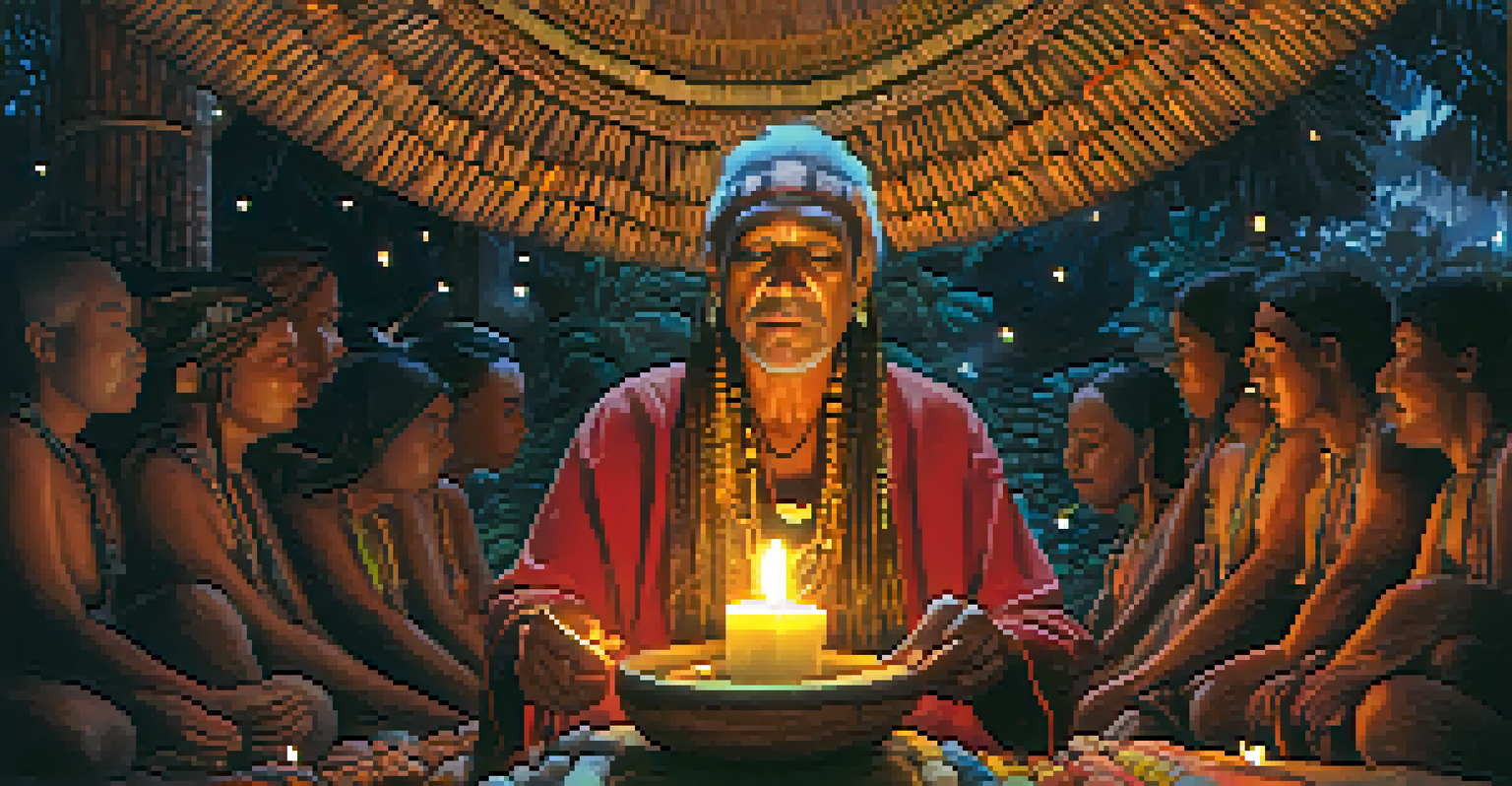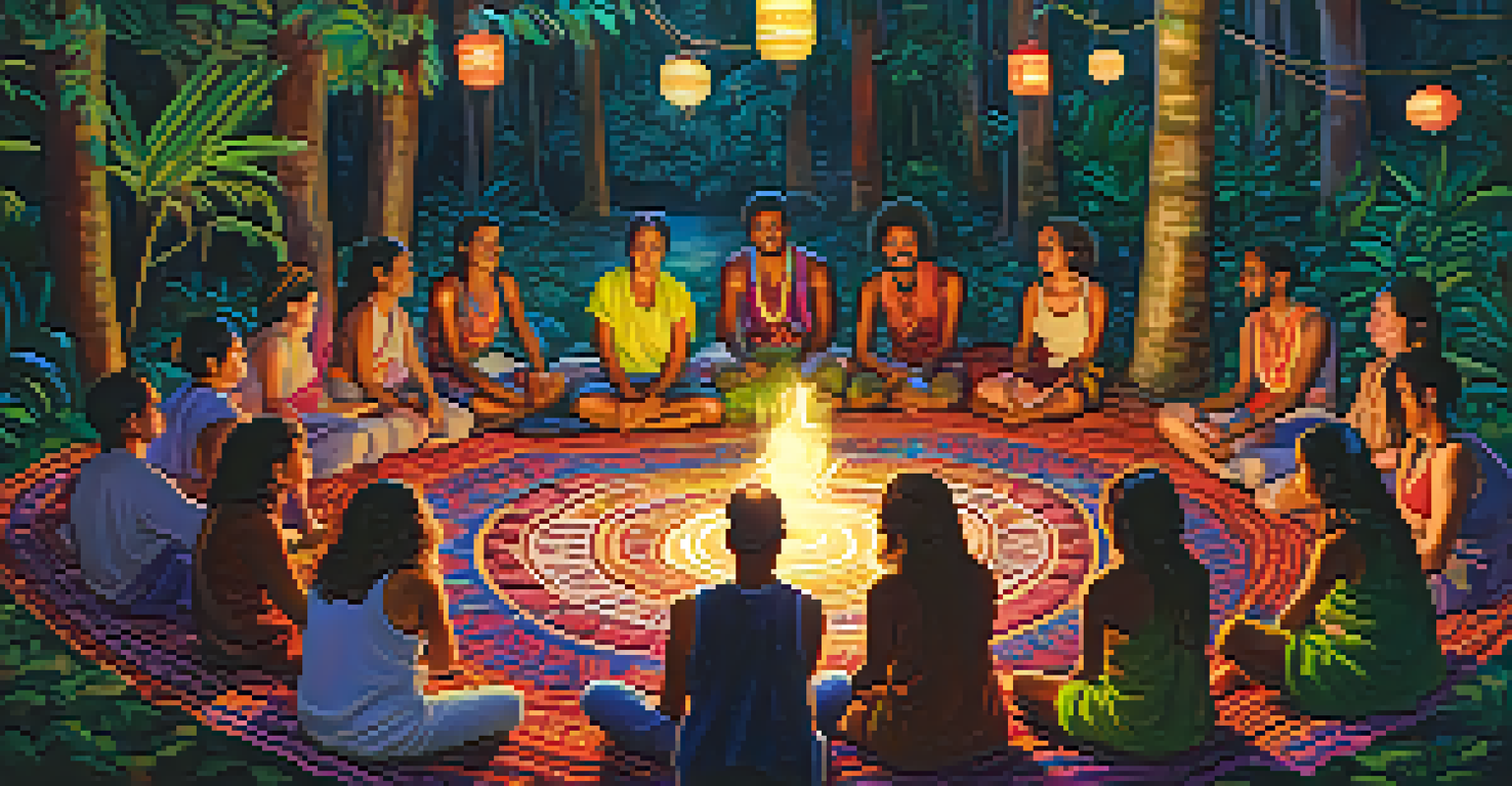Ceremonial Roles: Shaman and Participants in Ayahuasca

Understanding Ayahuasca and Its Cultural Significance
Ayahuasca, a powerful brew made from Amazonian plants, has deep cultural roots, particularly in indigenous communities. It is often used in spiritual ceremonies for healing and self-discovery, allowing participants to connect with their inner selves and the universe. The experience is traditionally guided by a shaman, who plays a central role in the ceremony.
The experience of Ayahuasca is a doorway to the soul, revealing the hidden layers of our being.
The shaman, or ayahuasquero, is not just a facilitator but a custodian of ancient knowledge. They possess a unique understanding of the plant's effects and how to navigate the spiritual journey. This cultural significance is crucial to appreciating the depth of the Ayahuasca experience.
In many ways, the shaman acts as a bridge between the physical and spiritual worlds. Participants often seek guidance and support from the shaman to help them interpret their experiences during the ceremony, making this relationship vital to the overall healing process.
The Role of the Shaman in Ayahuasca Ceremonies
The shaman's role is multifaceted, encompassing healer, guide, and spiritual leader. They prepare the Ayahuasca brew and create a sacred space that fosters safety and trust. This preparation is essential, as a well-structured environment can significantly influence participants' experiences.

During the ceremony, shamans use songs, known as icaros, to guide participants through their journeys. These melodies are believed to hold spiritual power, helping to protect and direct individuals as they navigate their visions. The shaman's ability to interpret these experiences is crucial for providing insight and support.
Participants Seek Healing and Insight
Individuals join Ayahuasca ceremonies to confront their fears and gain deeper self-understanding, supported by the communal experience.
Moreover, shamans often draw upon their extensive training and personal experiences to facilitate healing. Their deep connection to the plants, the spirits, and the participants allows them to tailor the ceremony to meet the specific needs of each individual, making their presence irreplaceable.
Participants: The Seekers of Healing and Insight
Participants in Ayahuasca ceremonies come from various backgrounds, often seeking healing, clarity, or a deeper understanding of themselves. This journey requires vulnerability, as participants must confront their fears and emotions during the experience. The willingness to engage with these challenges is essential for personal growth.
In the depths of the Ayahuasca experience, we find the stories that shape us and the wisdom that heals us.
The communal aspect of the ceremony also plays a significant role in the participants' experience. Sharing the journey with others fosters a sense of connection and support, allowing individuals to feel less isolated in their struggles. This shared experience can create bonds that last long after the ceremony ends.
Each participant's journey is unique, influenced by their intentions, past experiences, and the guidance of the shaman. This diversity enriches the ceremony, as individuals bring their stories and perspectives, contributing to a collective healing process that resonates throughout the group.
Setting the Stage: Preparing for the Ceremony
Preparation for an Ayahuasca ceremony is crucial for both shamans and participants. For participants, this often involves dietary restrictions and mental readiness, allowing the body and mind to be receptive to the experience. This pre-ceremony preparation can significantly affect the quality of the journey.
Shamans also engage in their own preparatory practices, which may include fasting, meditation, or rituals to connect with the spirit of the Ayahuasca. These practices help ensure that the shaman is in the right mindset to guide participants effectively. The ceremonial space is often cleansed and set with intentions to create a sacred atmosphere.
Importance of Ceremony Preparation
Both shamans and participants must prepare for the ceremony through rituals and mental readiness, ensuring a transformative experience.
This preparatory phase builds anticipation and fosters a sense of respect for the process. By acknowledging the importance of preparation, both shamans and participants set the foundation for a transformative experience that honors the traditions and significance of Ayahuasca.
The Ceremony: An Intense Spiritual Experience
During the Ayahuasca ceremony, participants consume the brew and enter a deeply introspective state. This experience can be intense, often eliciting vivid visions, emotional releases, and profound realizations. The shaman plays a vital role in guiding participants through these experiences, providing reassurance and support when needed.
The atmosphere during the ceremony is often charged with energy, as participants navigate their inner worlds. The shaman's presence, combined with the use of icaros, helps create a protective and nurturing environment. This allows individuals to explore their thoughts and emotions freely, fostering healing and insight.
As the ceremony unfolds, participants may encounter both challenging and enlightening moments. The shaman's guidance is crucial in helping them process these experiences, ultimately leading to a deeper understanding of themselves and their place in the world.
After the Ceremony: Integration and Reflection
After the ceremony concludes, the integration process begins. This phase is critical for participants to make sense of their experiences and incorporate the lessons learned into their daily lives. The shaman often provides support and guidance during this time, helping individuals navigate their reflections and insights.
Integration can take various forms, such as journaling, talking with others, or engaging in therapeutic practices. Participants may find it beneficial to share their experiences with the group or seek one-on-one discussions with the shaman. This ongoing dialogue can help solidify the healing that took place during the ceremony.
Shamans: Guides of Ayahuasca Journeys
Shamans play a crucial role in Ayahuasca ceremonies, acting as healers and spiritual guides who create a safe space for participants.
Ultimately, the goal of integration is to transform insights into actionable steps for personal growth. By actively engaging in this process, participants can foster lasting change and deepen their understanding of themselves and their journey.
The Mutual Respect Between Shamans and Participants
A deep mutual respect exists between shamans and participants in Ayahuasca ceremonies. This bond is built on trust, as participants rely on the shaman's expertise and guidance to navigate their journeys. Conversely, shamans respect the vulnerability and courage that participants show by engaging in such profound spiritual work.
This relationship is essential for creating a safe and supportive environment. When participants feel respected and understood, they are more likely to open up and fully engage in the healing process. This dynamic fosters a sense of community that enhances the overall experience for everyone involved.

Ultimately, the mutual respect between shamans and participants enriches the Ayahuasca ceremony, creating a space for healing, growth, and transformation. It highlights the importance of collaboration in spiritual practices and reinforces the idea that we are all interconnected on our journeys.